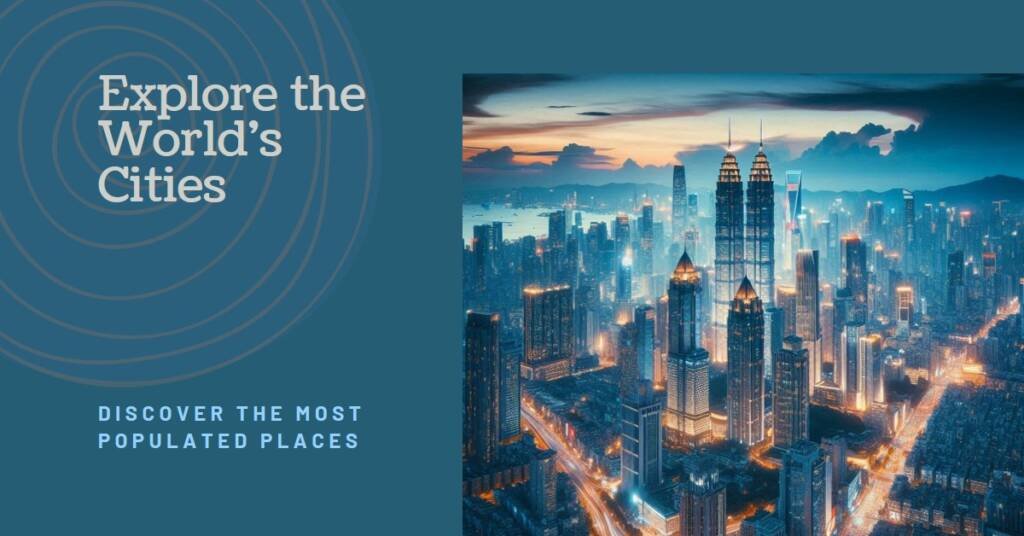
Table of Contents
- Introduction to Global Urbanization
- Criteria for Ranking Population
- Top 10 Most Populated Cities in 2022
- Impact of Population Density on Infrastructure
- Economic Aspects of High Population Cities
- Social and Cultural Influences
- Environmental Challenges Faced by Overpopulated Cities
- Future Projections for Urban Populations
- Conclusion: The Urban Future Ahead
Introduction to Global Urbanization
Global urbanization has seen remarkable growth in recent decades, with more than half of the world’s population now residing in urban centers. This phenomenon involves a significant shift from rural to urban living, driven largely by factors such as migration, economic opportunities, and advancements in urban planning. As populations in cities soar, understanding the intricacies of urbanization becomes crucial, particularly when examining the most populated cities around the globe.
One primary driver of urban population growth is migration. Individuals often move from rural areas to cities in pursuit of better job prospects, quality education, and improved living standards. This influx contributes to the rapid expansion of urban areas, leading to the formation of megacities—metropolitan regions with populations exceeding ten million. The allure of economic opportunities in urban centers attracts not only local residents but also those from distant regions, magnifying urban growth rates.
Economic factors play a significant role in shaping urban landscapes. Cities are typically considered engines of economic activity, fostering innovation and providing diverse job markets. As industries and businesses cluster in urban environments, they create a demand for labor, prompting rural populations to relocate. This creates a cyclical pattern where urban areas continuously expand as they attract talent and investment, thus enhancing their appeal for incoming migrants.
Furthermore, urban planning has evolved to accommodate the needs of growing populations, allowing cities to manage resources and infrastructure more effectively. Comprehensive city planning frameworks, which include transportation networks, housing developments, and public services, are essential to support the increasing urban populace. This proactive approach to urbanization not only contributes to economic stability but also improves the quality of life for city dwellers.
In observing these trends, it is clear that global urbanization is a major force shaping our world today. As cities grow and evolve, understanding the dynamics of this urban transformation will be crucial to addressing the challenges and opportunities that come with it.
Criteria for Ranking Population
Determining the population of cities is a complex task that involves several criteria and methodologies. One of the primary factors is the definition of city boundaries, which can vary significantly from one region to another. In many cases, cities are defined by their administrative limits, which include specific geographic and political boundaries. However, these may not always reflect the actual urban area where people live and work. For instance, suburbs that fall outside of a city’s formal limits may still have a significant number of residents who contribute to the overall metropolitan population.
Another essential aspect is the concept of metropolitan areas. A metropolitan area, or metro, typically includes a core city and its surrounding areas that are economically integrated with it. This includes surrounding towns and suburbs where residents commute daily for work or other purposes. This broader definition allows for a more accurate representation of population density and urban sprawl, highlighting the interconnectedness of urban and suburban living. Thus, organizations often rely on metropolitan statistical areas (MSAs) when compiling data on city populations.
The methodologies used for counting populations are varied and can include census data, surveys, and estimation techniques. While national governments conduct regular population censuses, these can differ in frequency and comprehensiveness. Furthermore, demographic data collection often entails using sampling methods to estimate populations in regions that are hard to access or where conducting a full census is impractical. Non-governmental organizations and researchers also contribute through studies that may involve extensive surveys and analytics. Innovative technologies such as satellite imagery and big data analytics increasingly play a role in enhancing the accuracy of these population assessments.
In conclusion, understanding the criteria for ranking urban populations helps clarify the complexities involved in city demographic analysis. Recognizing the distinctions between city boundaries and metropolitan areas, along with the methodologies used for data collection, is crucial in appreciating how population figures are determined and interpreted.
Top 10 Most Populated Cities in 2022
As of 2022, the world’s urban landscape is distinctly shaped by cities with staggering populations, each offering a unique blend of culture, history, and modernity. Here, we delve into the ten most populated cities that have garnered significant attention for their extensive urban populations.
Tokyo, Japan, holds the title of the most populous city, boasting an estimated population of over 37 million residents. This sprawling metropolis is recognized for its advanced technology and rich cultural heritage, attracting individuals from all corners of the globe. Its efficient public transport system and bustling markets contribute significantly to its population density.
Delhi, India, follows closely with approximately 31 million inhabitants. As one of the fastest-growing cities, its ongoing economic development, combined with its historical landmarks, draws vast numbers of migrants seeking better opportunities.
Shanghai, China also rankes high with a population of around 26 million. Renowned for its impressive skyline and vibrant commercial activities, Shanghai serves as a major financial hub, influencing population dynamics through job creation.
Sao Paulo, Brazil, housing nearly 22 million people, is celebrated for its diverse culture and culinary scene. This city integrates its historical roots with modern innovations, attracting individuals who seek both tradition and progress.
Mexico City, Mexico is another urban giant, hosting around 21 million residents. Its historical significance and contemporary urbanization contribute to its dense population, accented by a rich tapestry of art and cuisine.
Cairo, Egypt, with a population nearing 20 million, melds ancient history with modern challenges. The city is often busy, reflecting its role as a cultural and economic center in the Arab world.
Dhaka, Bangladesh has seen rapid population growth, currently standing at 20 million. Its vibrant textile industry and crowded streets outline the daily life of its inhabitants who seek economic advancement.
Osaka, Japan, with a population of around 19 million, combines its historical significance with modern urban living. It is a vital industrial hub that attracts professionals and families alike.
New York City, USA ranks high with approximately 18 million people in its metropolitan area. Known for its iconic landmarks and cultural diversity, New York remains a magnet for those chasing dreams of success and happiness.
Lastly, Karachi, Pakistan, with around 16 million residents, is recognized for its strategic location as a port city and economic center, contributing to its remarkable growth and urbanization.
These cities are not only population hubs but also reflect the socio-economic conditions and cultural richness of their respective regions, making them pivotal in today’s global landscape.
Impact of Population Density on Infrastructure
The population density of urban areas plays a crucial role in influencing the effectiveness and efficiency of infrastructure. As cities expand and become overcrowded, the challenges associated with high population densities intensify, significantly impacting transportation systems, housing availability, and public services. In many metropolitan regions, the strain on infrastructure is evident as the gap between demand and supply widens.
Transportation is significantly affected by increased population density. As more individuals inhabit small geographical areas, the transportation networks must adapt to accommodate the rising demand for efficient movement. Cities often struggle with traffic congestion, leading to longer commute times and increased pollution. To counteract these challenges, urban planners are forced to innovate, investing in more robust and sophisticated public transportation systems, cycling lanes, and pedestrian pathways. Innovations such as smart traffic management systems have emerged to optimize vehicle flow, demonstrating how cities can utilize technology to manage congestion effectively.
Housing is another critical area impacted by high population densities. The rapid influx of residents often leads to a shortage of affordable housing, placing tremendous pressure on existing facilities. In response, many cities are exploring innovative housing solutions such as high-density apartment complexes and mixed-use developments. These alternatives not only address the housing shortage but also promote communal living and improve land use efficiency. However, developers and policymakers must balance density with ensuring an adequate quality of life for residents.
Moreover, public services such as healthcare, education, and recreational facilities must also adapt to greater population concentrations. As demand for such services grows, municipalities are challenged to expand capacities and improve service delivery to meet residents’ needs. Collaboration between governmental agencies and private sectors has led to the development of more integrated services, providing an efficient response to the challenges posed by population density.
Economic Aspects of High Population Cities
The economic dynamics of the most populated cities significantly shape their development and growth. High population density facilitates a multitude of opportunities for businesses, fostering an environment ripe for innovation and entrepreneurship. In densely populated urban centers, a larger customer base emerges, allowing companies to scale their products and services effectively. Such an environment can lead to greater investment opportunities, attracting both local and foreign investments aimed at promoting economic growth and diversification. Furthermore, these cities often serve as major financial hubs, enhancing access to capital and resources critical for establishing and expanding businesses.
However, the fluctuation in economic prosperity is equally associated with several challenges linked to high population concentrations. A prominent issue is the potential for increased unemployment rates, which can occur when the growth of job opportunities fails to keep pace with the rising number of job seekers in these metropolitan areas. As populations swell, competition for employment can become fierce, leading to job insecurity and economic disenfranchisement for some residents. Moreover, high population cities are often marked by economic inequality, where the benefits of growth disproportionately favor a small segment of the population. This disparity can manifest in various forms, including access to education, healthcare, and housing, contributing to a widening socioeconomic gap.
Furthermore, the concentration of wealth and resources in major cities can inadvertently lead to issues such as gentrification and rising living costs. As urban areas attract more residents, particularly those with higher incomes, the demand for housing increases, driving up property prices and rental rates. Consequently, long-term residents may find themselves priced out of their neighborhoods, leading to additional social and economic tensions. Therefore, while the economic aspects of high population cities present significant opportunities, they also encompass multifaceted challenges that require strategic planning and policy intervention to ensure inclusive growth and stability.
Social and Cultural Influences
Living in densely populated cities in 2022 offers a unique tapestry of social and cultural influences that shape the experiences of residents. The diversity inherent in such urban environments often leads to vibrant cultural exchanges, where multiple ethnicities and traditions coexist, flourishing together. Immigrant populations play a crucial role in this dynamic, as they frequently contribute to the rich heritage of their new locales, adding flavors of their native customs, languages, and cuisines to the urban mosaic.
In densely populated areas, community interactions are both frequent and impactful. The amalgamation of different cultures fosters an environment ripe for dialogue and collaboration, encouraging residents to learn from one another. Social activities such as festivals, markets, and communal events become avenues for exploring diverse cultural expressions. These interactions can enhance social cohesion, allowing individuals from various backgrounds to forge connections that might not have been possible in less populated areas.
Cultural identity in urban settings is constantly evolving, influenced significantly by the multicultural fabric that characterizes these cities. As immigrants adapt to their new surroundings, their identities often blend with local traditions, creating hybrid cultures that reflect both heritage and contemporary influences. This evolution can lead to the emergence of new cultural practices and forms of expression, which, while rooted in various origins, contribute to a collective urban culture.
Moreover, the challenges of urban living—such as overcrowding, housing shortages, and social inequality—can also affect cultural dynamics by creating rifts or fostering tensions among different groups. However, these challenges can serve as catalysts for grassroots movements, encouraging solidarity and mutual support among residents. Ultimately, the social and cultural landscape of the world’s most populated cities is shaped by the interplay of diversity, community interactions, and the ongoing evolution of cultural identities within these vibrant urban spaces.
Environmental Challenges Faced by Overpopulated Cities
As urban populations continue to surge, the most populated cities in the world are encountering a plethora of environmental challenges that threaten not only the quality of life for their inhabitants but also the sustainability of the ecosystems surrounding them. One of the foremost issues is pollution, which significantly deteriorates air and water quality. The accumulation of vehicles, industrial activities, and construction projects generates substantial emissions, leading to hazardous air conditions. Cities like Delhi and Beijing, where rapid population growth outpaces environmental regulations, exemplify the dire consequences of unchecked pollution.
Moreover, waste management presents a formidable challenge in densely populated urban areas. The ever-increasing volume of waste generated by large populations, combined with inadequate infrastructure, often results in overflowing landfills and improper disposal of hazardous materials. Cities are thus compelled to explore innovative recycling programs, waste-to-energy solutions, and improved waste segregation techniques. The adoption of such initiatives aims not only at reducing landfill contributions but also at promoting a circular economy that conservatively utilizes resources.
Another critical aspect is the sustainable development efforts that cities are tasked with implementing to cope with high population densities. Urban planners face the challenge of balancing the need for expanded housing, transportation, and infrastructure with the imperative of preserving green spaces and natural habitats. Many metropolises invest in green architecture, urban gardens, and public transportation projects designed to reduce reliance on fossil fuels while enhancing the livability of urban environments. Cities are increasingly recognizing the importance of resilience and sustainability in urban development, but significant obstacles remain, particularly in regions characterized by economic constraints and limited governance.
In summary, the environmental challenges faced by overpopulated cities are multifaceted, encompassing pollution, waste management, and sustainable development. Addressing these issues is crucial for ensuring the health and sustainability of urban areas in an ever-growing global population. Properly navigating these challenges can lead to more livable cities capable of supporting their residents while safeguarding the environment.
Future Projections for Urban Populations
The dynamics of urban populations are subject to numerous factors that influence growth and evolution. Experts predict that the global urban population will continue to rise significantly over the next few decades, driven by various economic, social, and environmental changes. According to the United Nations, it is anticipated that by 2050, 68% of the world’s population will reside in urban areas, compared to 55% in 2020. This upward trend necessitates proactive planning and infrastructure development to accommodate the increasing population in major cities.
Economic factors play a crucial role in urban migration and population growth. As cities become centers of economic opportunity, individuals from rural areas migrate in search of better employment prospects. The economic development in urban regions leads to enhanced living standards, healthcare access, and educational opportunities, making cities more attractive to various demographics. Furthermore, the globalization of markets and industries is likely to fuel the growth of mega-cities as they become pivotal economic hubs.
Social factors, such as cultural integration and diversity, also contribute to urban growth. Cities often serve as melting pots for different cultures, which fosters innovation and entrepreneurship. As people from diverse backgrounds settle in urban areas, they bring different skills and ideas, which can enhance the city’s overall productivity and sustainability. However, this influx can also lead to challenges, including increased demand for housing, social services, and transportation.
Environmental changes cannot be overlooked when considering future urban population trends. Climate change is prompting shifts in human settlement patterns, with some areas becoming less hospitable due to rising sea levels and extreme weather events. On the other hand, urban areas that prioritize sustainability and resilience may attract populations seeking safer living conditions. Efficient urban planning and investment in green technologies will be essential in accommodating anticipated growth while minimizing adverse effects on the environment.


Conclusion: The Urban Future Ahead
The exploration of the most populated cities in the world in 2022 has revealed significant trends and challenges faced by urban centers as they accommodate vast numbers of inhabitants. As the global population continues to soar, with an increasing number gravitating towards urban living, cities are transforming into dynamic hubs that demand strategic planning and sustainable development. Given the diversity in the population densities of metropolitan areas such as Tokyo, Delhi, and Shanghai, it becomes evident that each city’s unique challenges warrant tailored solutions. The implications of ongoing urbanization are profound and multifaceted, affecting everything from infrastructure and housing to transportation and environmental quality.
As urban areas evolve, the importance of forward-thinking urban strategies cannot be overstated. Policymakers and urban planners must prioritize the integration of green spaces, efficient public transport systems, and affordable housing solutions to foster livability. Moreover, addressing social inequalities within these populous cities is crucial. Urban sustainability relies on the ability to adapt to changing demographics and economic conditions while ensuring accessibility for all residents. Strategies should focus on leveraging technology and innovation to create smarter cities that can better manage resources and enhance the quality of life.
Additionally, with challenges such as climate change, resource scarcity, and socio-economic disparities looming over urban environments, the responsibility falls on various stakeholders, including governments, community leaders, and private organizations, to collaborate and implement solutions that are both socially inclusive and environmentally conscious. Ultimately, the future of the most populated cities hinges on adopting innovative approaches that prioritize sustainability, resilience, and inclusiveness. By embracing these principles, urbanization can be a force for good, enhancing the lives of millions and shaping the cities of tomorrow.



